In the culinary world, precise measurements are essential for achieving consistent and delicious results. However, cooking and baking often require different measurement systems, which can lead to confusion. Understanding how to convert between various units, such as cups to ounces and teaspoons to milliliters, is crucial for any home cook or professional chef. This blog post will explore these conversions in detail, helping you navigate your recipes with confidence.
Why Conversions Matter in Cooking
Accurate measurements can make the difference between a successful dish and a culinary disaster. Different regions use different measurement systems, with the most common being the US customary system and the metric system. Knowing how to convert between these systems is essential, especially if you’re using recipes from different sources or cooking for an international audience.
Check out our Types of Unit Converters
Common Measurement Units
Before diving into conversions, let’s familiarize ourselves with the common units used in cooking:
- Cups (c): A standard measurement in the US, often used for liquids and dry ingredients.
- Ounces (oz): Used for both weight and volume; fluid ounces are used for liquid measurements, while ounces can refer to weight.
- Teaspoons (tsp): A small measurement typically used for spices and flavorings.
- Milliliters (mL): A metric unit for volume, often used in cooking and baking for precision.
Converting Cups to Ounces
One of the most common conversions in cooking is from cups to ounces. Understanding this conversion can help you adjust recipes to your liking or use the right tools in your kitchen.
Conversion Formula
\( 1 \text{ cup} = 8 \text{ fluid ounces (fl oz)} \)
Examples
- 1 cup of water = 8 fl oz
- 2 cups of flour = 16 fl oz
- ½ cup of milk = 4 fl oz
Practical Application
Suppose you have a recipe that calls for 2 cups of chicken broth, but your measuring cup only shows ounces. To find out how much broth you need, simply multiply:
\( 2 \text{ cups} \times 8 \frac{\text{fl oz}}{\text{cup}} = 16 \text{ fl oz} \)
Thus, you’ll need 16 fluid ounces of chicken broth for your recipe.
Converting Teaspoons to Milliliters
Teaspoons are often used for smaller quantities, while milliliters are a more precise measurement commonly found in many recipes. Converting between these two units is essential for accuracy in flavoring your dishes.
Conversion Formula
\( 1 \text{ teaspoon} = 5 \text{ milliliters (mL)} \)
Examples
- 1 tsp of vanilla extract = 5 mL
- 3 tsp of sugar = 15 mL
- ½ tsp of salt = 2.5 mL
Practical Application
If a recipe calls for 2 teaspoons of olive oil but you only have a measuring spoon that shows milliliters, you can convert it as follows:
\( 2 \text{ tsp} \times 5 \frac{\text{mL}}{\text{tsp}} = 10 \text{ mL} \)
So, you will need 10 milliliters of olive oil for your dish.
Other Useful Cooking Conversions
Converting Between Different Units
- Tablespoons to Teaspoons:
- 1 tablespoon (tbsp) = 3 teaspoons (tsp)
- Example: 2 tbsp = 6 tsp
- Cups to Milliliters:
- 1 cup = 236.6 milliliters (mL)
- Example: 1.5 cups = 354.9 mL
- Fluid Ounces to Milliliters:
- 1 fl oz = 29.57 mL
- Example: 8 fl oz = 236.6 mL
Using Conversion Tables
For ease of use, consider keeping a conversion chart in your kitchen. Here’s a quick reference table:
| Cups | Fluid Ounces | Teaspoons | Milliliters |
|---|---|---|---|
| 1 cup | 8 fl oz | 48 tsp | 236.6 mL |
| ½ cup | 4 fl oz | 24 tsp | 118.3 mL |
| ⅓ cup | 2.67 fl oz | 16 tsp | 78.9 mL |
| ¼ cup | 2 fl oz | 12 tsp | 59.1 mL |
| 1 tbsp | 0.5 fl oz | 3 tsp | 14.8 mL |
Tips for Accurate Measurements
- Use the Right Tools: Invest in quality measuring cups and spoons for both dry and liquid ingredients. Liquid measuring cups typically have a spout for pouring and are marked for fluid ounces and milliliters.
- Level Off Dry Ingredients: When measuring dry ingredients like flour or sugar, use a straight edge to level off the top for accuracy.
- Don’t Pack Ingredients: When measuring brown sugar or similar ingredients, avoid packing it into the cup unless the recipe specifically calls for packed sugar.
- Check Temperature: For some ingredients, such as butter, using the correct temperature can affect the measurement. For instance, melted butter takes up less space than solid butter.
Try out our Free Math and English Worksheet Generators
Converting cooking measurements is a fundamental skill that every home cook should master. Whether you’re adapting a recipe from a friend or trying out a new dish from an international cookbook, knowing how to convert between cups, ounces, teaspoons, and milliliters can enhance your cooking experience.
